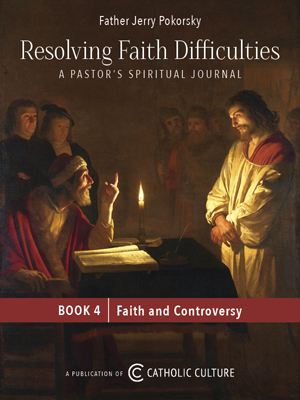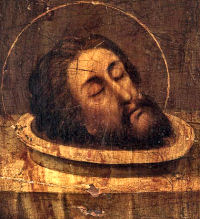Ordinary Time: August 29th
Memorial of the Passion of Saint John the Baptist
Other Commemorations: St. Sabina, Martyr (RM); St. Mary of the Cross (Jeanne Jugan), Religious (RM)
» Enjoy our Liturgical Seasons series of e-books!
The Church, having celebrated the earthly birthday of St. John the Baptist on June 24, today honors the anniversary of his martyrdom. Besides our Lord and our Lady, St. John the Baptist is the only one whose birth and death are thus celebrated. Today's Gospel relates the circumstances of his execution. He had the courage to blame Herod to his face for the scandal of his illegal union with his sister-in-law Herodias, whose husband was still alive. Herodias contrived to make Herod imprison him and took advantage of an unexpected opportunity to obtain through her daughter Salome the beheading of the saint.
According to the 1962 Missal of St. John XXIII the Extraordinary Form of the Roman Rite, today is the feast of St. Sabina. The titular church of St. Sabina of the Aventine is a gem of Christian architecture. It owes its origin to the generosity of a Roman lady of the name of Sabina who gave to the Christian community the house that she possessed in this aristocratic quarter of Rome. The martyrologies also commemorate another St. Sabina who died in Umbria. The identity of name has caused confusion between the two women.
Passion of John the Baptist
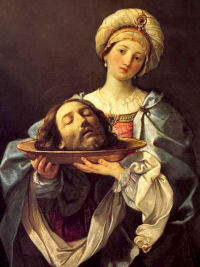 In addition to the feast of the nativity of St. John the Baptist (June 24), the Church, since the fourth century, commemorates the martyrdom of Christ's precursor. According to the Roman Martyrology, this day marks "the second finding of his most venerable head." The body of the saint was buried in Samaria. In the year 362 pagans desecrated the grave and burned his remains. Only a small portion of his relics were able to be saved by monks and sent to St. Athanasius at Alexandria. The head of the saint is venerated at various places. That in the Church of St. Sylvester in Rome belongs to a martyr-priest John. Also in the Dominican church at Breslau the Baptist's head is honored.
In addition to the feast of the nativity of St. John the Baptist (June 24), the Church, since the fourth century, commemorates the martyrdom of Christ's precursor. According to the Roman Martyrology, this day marks "the second finding of his most venerable head." The body of the saint was buried in Samaria. In the year 362 pagans desecrated the grave and burned his remains. Only a small portion of his relics were able to be saved by monks and sent to St. Athanasius at Alexandria. The head of the saint is venerated at various places. That in the Church of St. Sylvester in Rome belongs to a martyr-priest John. Also in the Dominican church at Breslau the Baptist's head is honored.
—Excerpted from The Church's Year of Grace, Pius Parsch
There is no doubt that blessed John suffered imprisonment and chains as a witness to our Redeemer, whose forerunner he was, and gave his life for him. His persecutor had demanded not that he should deny Christ, but only that he should keep silent about the truth. Nevertheless, he died for Christ. Does Christ not say: "I am the truth"? Therefore, because John shed his blood for the truth, he surely died for Christ.
Through his birth, preaching and baptizing, he bore witness to the coming birth, preaching and baptism of Christ, and by his own suffering he showed that Christ also would suffer.
Such was the quality and strength of the man who accepted the end of this present life by shedding his blood after the long imprisonment. He preached the freedom of heavenly peace, yet was thrown into irons by ungodly men. He was locked away in the darkness of prison, though he came bearing witness to the Light of life and deserved to be called a bright and shining lamp by that Light itself, which is Christ.
To endure temporal agonies for the sake of the truth was not a heavy burden for such men as John; rather it was easily borne and even desirable, for he knew eternal joy would be his reward.
Since death was ever near at hand, such men considered it a blessing to embrace it and thus gain the reward of eternal life by acknowledging Christ's name. Hence the apostle Paul rightly says: "You have been granted the privilege not only to believe in Christ but also to suffer for his sake." He tells us why it is Christ's gift that his chosen ones should suffer for him: "The sufferings of this present time are not worthy to be compared with the glory that is to be revealed in us."
—Saint Bede the Venerable
Patronage: See CatholicSaints.info for the long list of patronage.
Highlights and Things to Do:
- Read more about this feast:
- Read this article, St. John the Baptist: Martyr for the Truth about Marriage.
- Watch this informational video at Gloria TV.
- See Catholic Cuisine for feast day food ideas.
- Visit Christian Iconography for images of St. John the Baptist.
- It is uncertain where the head of St. John the Baptist is. There are 4 purported heads around the world. There is also the relics of his arm and finger. It is hard to sift through authentic relics at times. It was a lucrative attraction to have popular saints' relics and sacred objects. The pilgrimages to venerate the relics financially helped regions. And with the destruction of various churches and abbeys during revolutions (such as in France) and persecutions (such as in England), it makes the provenance even harder to track down.
St. Sabina
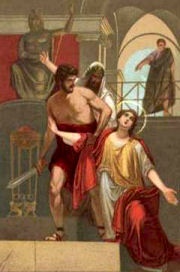 According to legend, Sabina was born in Vindena, Umbria, and became the wife of a notable person having the name Valentine. She was converted to the faith by her maid Serapia, a Christian virgin. When Serapia died a martyr's death (her feast occurs on September 3 in the Roman Martyrology), Sabina gave her servant's holy body an honorable burial. On that account she was cast into prison by Emperor Hadrian and brought before the judge Elpidius. "Are you Sabina, illustrious by family and marriage?" he asked. "Yes, I am," came the reply, "but I thank my Savior Jesus Christ that through His servant Serapia He has freed me from the power of hell." Due to her contempt of the gods, she was condemned to death. Christians buried her body in the same grave as her teacher in the faith.
According to legend, Sabina was born in Vindena, Umbria, and became the wife of a notable person having the name Valentine. She was converted to the faith by her maid Serapia, a Christian virgin. When Serapia died a martyr's death (her feast occurs on September 3 in the Roman Martyrology), Sabina gave her servant's holy body an honorable burial. On that account she was cast into prison by Emperor Hadrian and brought before the judge Elpidius. "Are you Sabina, illustrious by family and marriage?" he asked. "Yes, I am," came the reply, "but I thank my Savior Jesus Christ that through His servant Serapia He has freed me from the power of hell." Due to her contempt of the gods, she was condemned to death. Christians buried her body in the same grave as her teacher in the faith.
—Excerpted from The Church's Year of Grace, Pius Parsch
Highlights and Things to Do:
- Read more about St. Sabina:
- Make a virtual visit to the Basilica of Santa Sabina in Rome. For more about Santa Sabina see
- See origins and transformations over the years for Santa Sabina.
- The Church of Santa Sabina is well-known because it is the first Station Church of Lent, opening on Ash Wednesday. It has been a few years since the pope came on Ash Wednesday, but Pope Benedict XVI visited on February 22, 2012. The last time was in 2020. Pope Francis was returning for 2022, but had to cancel due to health reasons.
St. Mary of the Cross (Jeanne Jugan)
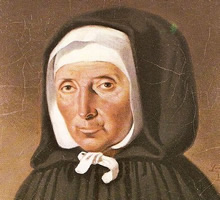 St Mary of the Cross (in the world: Jeanne Jugan) was born at Cancale, in Brittany, France, on 25 October 1792 in the turbulent period of the French Revolution. She was the sixth of eight children, four of whom died in infancy. Their fisherman father was lost at sea when Jeanne was only four. From her mother and the place of her birth, Jeanne inherited a lively, deep faith and a profound determination that could overcome any difficulty. The political climate and the family's financial plight prevented Jeanne from going to school. She learned to read and write from some ladies of the Third Order of St John Eudes who were numerous in the region.
St Mary of the Cross (in the world: Jeanne Jugan) was born at Cancale, in Brittany, France, on 25 October 1792 in the turbulent period of the French Revolution. She was the sixth of eight children, four of whom died in infancy. Their fisherman father was lost at sea when Jeanne was only four. From her mother and the place of her birth, Jeanne inherited a lively, deep faith and a profound determination that could overcome any difficulty. The political climate and the family's financial plight prevented Jeanne from going to school. She learned to read and write from some ladies of the Third Order of St John Eudes who were numerous in the region.
In Jeanne's world children began working at an early age. She would pray her Rosary while tending the herd, on the high cliffs above the Bay of Cancale. The beautiful view uplifted her soul. At the age of 15 she left home and went to work in a wealthy family not far from Cancale. With her new employer, she went to the help of the needy.
In 1801 Napoleon Bonaparte restored religious freedom and a true spiritual awakening ensued. Numerous missions were preached and it was in this fervent atmosphere that the future Foundress of the Little Sisters of the Poor heard the Lord's call.
When a young man asked for her hand in marriage she told him that God wanted her for himself, and was keeping her for a work as yet unknown. And as an immediate response she divided her clothes into two piles, leaving the prettiest to her sisters. She then left for Saint-Servan where for six years she worked as an assistant nurse. She enrolled in the Third Order of St John of Eudes. From that time her one desire was to "be as humble as Jesus".
Health problems obliged Jeanne to leave the hospital. She was taken in by a friend in the Third Order, Miss Lecoq, whom she would serve for 12 years until her death in 1835. In 1839, Jeanne was 47 years old and shared an apartment with two friends: Fanchon, 71, and Virginie Trédaniel, a 17-year-old orphan. In Saint-Servan at that time the economic situation was disastrous; 4,000 out of population of 10,000 were reduced to begging.
One winter evening in 1839, she came across a poor and blind old lady. Jeanne did not hesitate to give the lady her own bed. This was the initial spark that kindled a great blaze of charity. From that time, Jeanne was not to be deterred. In 1841 she rented a large room in which she welcomed 12 elderly people. In 1842, without money, she purchased a dilapidated convent where she soon provided 40 elderly persons with accommodation.
Encouraged by a St John of God brother, she begged for the poor in the streets and founded her institution on abandonment to Providence. In 1845 she won the Montyon Prize, awarded each year "to a poor French man or woman for outstandingly meritorious activity". She founded homes in 1846 in Rennes and in Dinan, in 1847 in Tours, and in 1850 in Angers. The Congregation spread throughout Europe, America, and Africa and shortly after her death, to Asia and Oceania.
It would seem that this fruitfulness was the result of a total and radical dispossession. In 1843, Jeanne had been re-elected Superior. Contrary to all expectations and solely on his own authority, Fr Le Pailleur, named as Superior instead Marie Jamet, who was 21 years old. In his action, Jeanne discerned God's will and supported the work, encouraging the younger sisters by her example.
In 1852, the Bishop of Rennes officially acknowledged the Congregation and appointed Fr Le Pailleur Superior General. His first act was to call Jeanne Jugan back definitively to the Motherhouse for a retirement that was to last 27 long years.
The younger sisters, ever increasing in number with the expansion of the Congregation, did not even realize that she was their Foundress. Jeanne, living in their midst, with her serenity and wisdom, transmitted a constant spirit of praise. "Love God very much; he is so good. Let us entrust ourselves to him".
She died peacefully on August 29, 1879. Her Congregation then numbered 2,400 Little Sisters in 177 homes on three continents. St. John Paul II beatified her on October 3, 1982.
—Excerpted from the Vatican Website
Highlights and Things to Do:
- Read more about St. Jeanne Jugan:
- Learn about the Little Sisters of the Poor founded by Jeanne Jugan.




